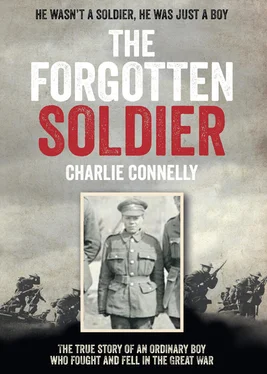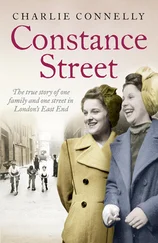It’s an incongruous sight, this pi symbol in three dimensions: a grave from a possibly mythical fight in a farmer’s field high on the North Downs. There’s even some doubt that Vortigern and his sons even existed, making this visit to Kit’s Coty practically the antithesis of my own quest. Here was an event and people whose lives and stories might possibly have been conjured from thin air, or loosely based on facts, that had lasted through many centuries, while I was making a journey to find someone who had certainly existed, yet had passed entirely from memory within a generation of his death.
In the afternoon I rested for a while on a bench at the top of the village of Detling, next to its RAF memorial, before pressing on, passing through some of Kent’s – and England’s – most beautiful countryside. I had found a good walking rhythm at this stage and my steps and breathing were in perfect tandem, creating an almost trance-like state in which I rarely looked up from a spot on the road a few yards in front of me. The miles and hours were disappearing under my feet on a flat, single-track road, as I headed east between rape fields of deep-green stalks sprinkled lightly with yellow that would be ablaze with colour a week or two hence.
After what must have been a good hour or more after leaving Detling, I lifted my gaze from the tarmac in front of me and was stopped dead in my tracks. I’m not usually one for postcard representations of England. For me, a suburban street of terraced houses with a Mace on the corner evokes England as much as an ivy-clad thatched cottage with a well in the garden, but the sight that greeted me there on the road somewhere in Kent was enough to terminate my walking rhythm and bring me to a toe-crunching halt.
The day was easing towards late afternoon and the fledgling shadows were just gaining the confidence to commence lengthening. In the field to my right two horses, one brown, one white, grazed lazily, the late afternoon sun warming every detail and contour of their bodies. Behind them, the white-tipped conical roofs of two oast houses peeped over some trees, while in the distance a square church tower interrupted the hazy horizon. Above the idyllic scene was a bright-blue canopy marked only with a few cotton-wool puffs of cloud. Somewhere up there, a skylark was singing its tiny lungs out as, in the distance, the church bell began to ring.
This was just the kind of idyll for which the soldiers were told they were fighting: the classic image of England, the type of scene crying out for a soundtrack by Vaughan Williams and captured by generations of painters. It was a vista that had remained unchanged for a good couple of centuries, the same bell tolling for generations, the same birdsong from the heavens, the same shadows stretching across the grass year after year. I stood for a while, watching nothing in particular yet watching everything: history, nature and society in a view utterly devoid of people but which has somehow come to define a people.
Once I’d got moving again, perhaps lulled too far by this watercolour perfection and having spied on the map a dotted green line that represented a more direct public footpath route to Harrietsham, I left the waymarked security of the North Downs Way to struggle clumsily across a recently ploughed field. Too accustomed to the well-trodden, signposted trail, I’d been tempted into a shortcut, one I messed up and led to me straying unawares into a wood that turned out to be private property. Ahead of me I heard the throaty rumble of a quad bike on which a man dressed in a green sweatshirt and combat trousers appeared, pulled up, switched off the engine and regarded me as if he’d just walked into his living room and found me sitting in his favourite armchair flicking through the television channels. Fortunately his initial save-it-for-the-judge-bucko demeanour as I explained where I thought I was soon gave way to a helpful point in the direction of the public footpath I’d believed I was on. Thankfully he’d realised he was just dealing with an incompetent buffoon with barely cursory map-reading skills rather than someone intent on pilfering birds’ eggs or putting on some kind of free festival. He even gave me a cheery ‘happy hiking’ as he gunned the quad bike and plunged back into the undergrowth.
Once on the right path – which turned out to be ankle-deep in mud – I arrived in Harrietsham just as the shadows disappeared into the twilight and lights were winking on behind thick cottage walls. The weatherboarded Roebuck Inn was blue-white in the gloom, and I stayed there the night, my feet sore and my face tingling from the unseasonably warm weather. Warm though it was – strangely so for late March – even in the height of summer the fate of the long-distance walker is such that one is forced to crank up the radiators to ensure the underwear and socks rinsed out in the sink are dry by the morning.
It was another sunny day as I headed out of the village the next morning to pick up the trail. After half a mile or so I came upon a bench, at one end of which sat a full-sized wooden sculpture of a fat friar cheerfully asleep, with his head resting in his hand to remind you that this path was also part of the ancient Pilgrim’s Way. I sat with him for a while, looking out across the valley as the Sunday morning church bells echoed around the villages, and could easily have joined him in a morning snooze if I hadn’t needed to be in Wye by sunset.
Late in the afternoon I stopped to rest at a ruined church by a lake below a grand old house. All that remained were a tower, a small section of wall and a tiny side chapel. St Mary’s, Eastwell, dates back to the fifteenth century, and the flint-built tower in front of me was part of this original construction. It was a peaceful, shady spot and I ended up staying longer than I’d anticipated, poking around the graveyard, reading the stones and just sitting looking through the trees to the lake and listening to the birdsong echoing from inside a belfry long ago relieved of its bells.
I was sitting on a stone slab that, judging by the remains of the walls around me, was once inside the main body of the church. St Mary’s had been badly damaged during the Second World War, then all but abandoned afterwards. In earlier times it would have been the place of worship for the family and workers of the Eastwell Place estate, but presumably an evolving social structure and the impact of the Second World War had seen the congregation decline almost to nothing. When the roof fell in in 1951 repair seemed pointless. The nave and everything but the tower, the small stretch of wall and the little chapel were demolished and removed in 1956, leaving just a tranquil ruin to be gently reclaimed by nature.
I didn’t realise until I stood up to leave, but the slab on which I’d been resting my weary bottom was actually the key to the greatest story associated with St Mary’s. It’s a rectangular rubble-brick construction with a flat stone top, on the front of which is a plaque that’s quite hard to decipher unless you squat down in front of it and look closely, to read: ‘Reputed to be the tomb of Richard Plantagenet, 22 December 1550’.
Richard Plantagenet, who was born around 1470, was an illegitimate son of Richard III, a boy raised in isolation, living and working with a tutor with very occasional visits from a man dressed in fine clothes the only break in the routine of endless one-to-one study. One day in 1485 the teenage Richard was hurriedly dressed by the tutor, put onto a horse and taken on a long journey that ended at a field in Leicestershire full of tents and apprehensive-looking soldiers: this was the eve of the Battle of Bosworth Field, the ultimate showdown of the Wars of the Roses. Young Richard was shown into the grandest tent of them all, where someone he recognised as the man who had been visiting him for as long as he could remember introduced himself as his father. If that wasn’t surprise enough for someone who had met few people other than the old boy who drummed Latin declensions into him, the man in the tent continued, ‘My boy, I am the King of England today, but heaven knows what I may be tomorrow, for the rebels are strong. If the Earl of Richmond wins the day he will seek out Plantagenets wherever they may be and crush them. Tell no one, absolutely no one, who you are unless I am victorious.’ This was to be Richard’s last meeting and only conversation with his father.
Читать дальше












